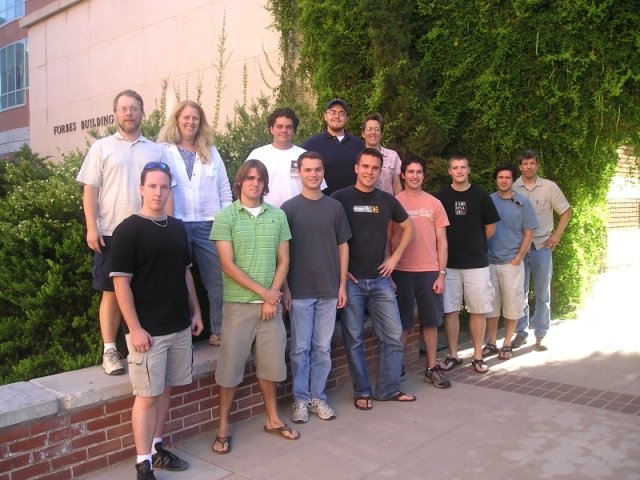University of Arizona 2006
From 2006.igem.org
University of Arizona 2006
Contents |
Team members
| Member | Contact | Role | |
|---|---|---|---|
| Joan Curry | curry@ag.arizona.edu | Faculty Advisor | |
| Mark Riley | riley@ag.arizona.edu | Faculty Advisor | |
| Patrick Hollinger | dogmod@email.arizona.edu | Lab Lead / Design | |
| Josh Kittleson | jkittles@email.arizona.edu | Lab work, Design | |
| Tim Spriggs | tims@u.arizona.edu | Project Manager / Documentation | |
| Tyler Brown | tylerb@email.arizona.edu | Documentation | |
| Dan Reavis | danman1@email.arizona.edu | ||
| Kevin MacDow | macdow@email.arizona.edu | ||
| Brian Heinze | heinze@email.arizona.edu |
Meetings
Lab Work: All week in morning, afternoon
Next Meeting: Mon 7/24 in Shantz 440 at 4:00 pm
Resources
Local Resources
Articles and References
Related Projects and Links
Projects
Our project ideas are still under development but for progress you may visit our Project Ideas.
We also maintain a forum for internal team communication. This is available at our Team Forum.
The "Water Color" project (we don't have an official name yet) is the current project that we will be building. As of now, we will be focusing our attention on building this design. We want to start with a system that is not complex and that is straightforward to build. So that we can learn while we build. We want to add complexity later, after we have made what is already designed.
Project Details
The current name of our project is "Water Color." It is a system that selectively expresses one of three florescence proteins. Each of the three florescence proteins will be expressed in the presence of a unique inducer. Each florescent protein will be controlled by a unique repressed promoter.
The idea of our project is to have a media with these cells on it so that each cell will be individually activated to shown a certain "color" (in actuallity, express one florescent protein, which may or may not look unique). Thus the media is able to dispaly an image. A further idea, to be implemented later, is to have the ability to "erase" the image. This would be accomplished by repressing all three promoters.
All the requisite parts have been identified from the registry, and will be built together. (More detail on the specific part numbers and a diagram will be added later)
A flowchart of the parts construction is completed at Parts Schedule
We are currently in Phase III of the construction (much to our plesant surprise). This has not taken too long to reach this far, therefore, we will have time to add improvements to the design.
Visualization
One hurdle to overcome is how should we visualize the image. We know that two of the flourescent proteins look very similar by the naked eye, even though they produce light of different wavelengths. Ideas that we have to better visualize the image include:
- Making three plates (each one color) for each image and digitally adding color
- Use light filters to distinguish the proteins
- View under a microscope
Placing the inducer(s)
After the challenges of the first aspect of the project are overcome, more mechanical challenges still exist. For example: How to place the inducers?, or What scale should the image be?, or Are any optical techniques needed to fully visualize the image?
Inkjet Printer
The first idea to place the inducers on the media is to use an injet printer. The printer could print solutions of inducers on a thin sheet which can be placed onto the media to put the inducers in contact with the cells. Issues that arrise are:
- The size of molecules and the aperature of the jet
- The fluid properties of the solution (e.g. viscosity) should match ink
- The sheet needs to effectively transfer the solutions to the media without mixing of regions
Rapid Prototyping Mold
Digital images could be parsed into its three separate colors. The area were there is color is then cut into a block (not in actuality, it is RP'ed in one step). The block is then used to cast a PDMS mold that will be used as a stamp to place the inducers on the plate of cells.
PDMS Mold
Similar to the above idea, a PDMS mold with microfluidic channels is made so that a liquid (a solution of inducer) is able to be selectively placed on the plate of cells.
Photos
Team photo shown above, more to come.
